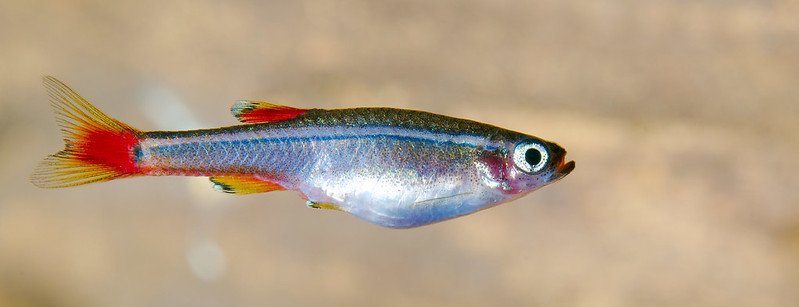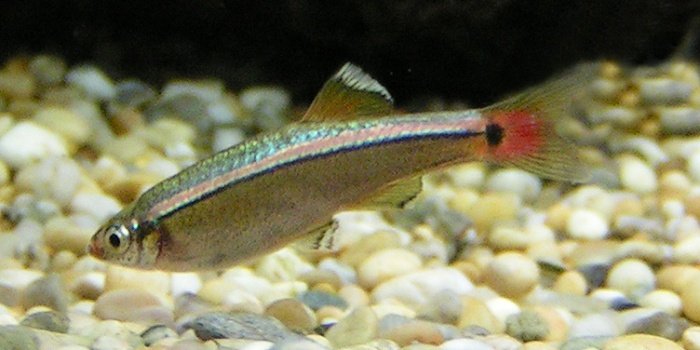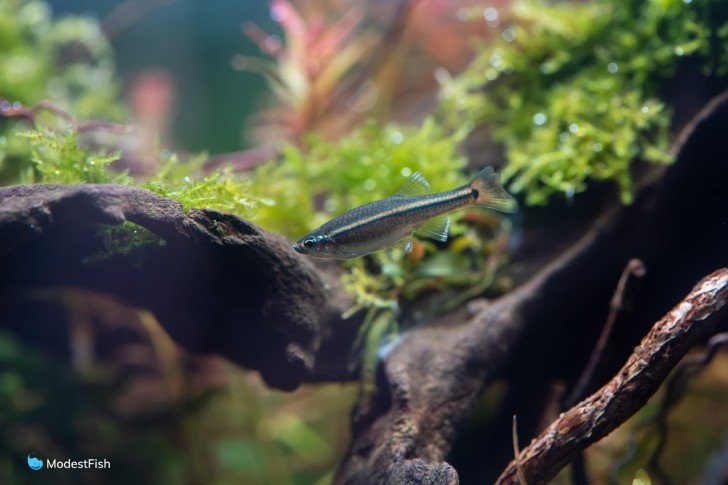White Minnows are a somewhat perfect species for your aquarium. While they may not be the first name to come to your mind when raising fish, they make for delightful pets. They’re bright-colored to liven up your aquarium. Moreover, they have small sizes, which means you won’t need to upgrade your tank into a bigger one.
In this guide, you’ll learn everything you need to know in order to provide optimal aquarium care for white cloud mountain minnows.
Origin & Appearance: White Cloud Minnow
White Minnows were initially found in China, specifically in north Guǎngzhōu. They’re considered a new species as they were only discovered in the 1930s. Unfortunately, pollution drove the fish away, and they were deemed to be extinct for nearly 20 years. Luckily, another population was found in Hainan Island a few years ago.
This fish type has a high level of durability. It often lives in slightly cold water, with temperatures ranging from 65 to 73 degrees Fahrenheit. While it may survive in cooler water, this range is the optimum habitat.

Those hardy Minnows prefer a flowy environment to live in. Suitably, they can be found near streams of mountains. For an ideal habitat, the streams are often of low pH.
The Minnows are relatively small fish; they don’t grow further than 1.5 inches. They have slim dart-like shapes, topped with a red pointed snout. Their mouths are tilted upwards with slightly sticking-out jaws. As for the dorsal and ventral fins, they take the shape of a triangle, aiming towards the back of their bodies.
They exhibit silver, sometimes green scales with shimmering pink and black lines decorating their lateral lines. Therefore, they’re quite a delight to look at.
Care Stats Overview
- Common name: Canton Minnow, or Cardinal Fish
- Tank size: 15-gallon aquarium as a minimum
- Temperature: 65-73°F (Survives fluctuations no higher than 80°F)
- pH: 6.8-7.5 is optimum
- kH: 5-20°H
- Living zone: Freshwater
- Temperament: Schooling and peaceful (Except when mating)
- Diet: Omnivores
Scientific Classifications
- Kingdom: Animalia
- Phylum: Chordata
- Class: Actinopterygii
- Order: Cypriniformes
- Family: Cyprinidae
- Genus: Tanichthys
- Species: Tanichthys albonubes
Life Span For White Cloud Minnows
One of the reasons why Minnows are a perfect choice for an aquarium is their life span. Their life expectancy ranges from 5 to 7 years. This number may be affected by the presence of a disease. Although Minnows are pretty hardy, they can be attacked with Streptococcal infection. It’s a viral infection that can be prevented by maintaining a clean tank.
Sexual Dimorphism: Size & Coloration
It may be challenging to differentiate between male and female Minnows. Don’t worry, though! We’ve got you. The difference is noticeable if you know what you are looking for. When considering sizes, you’ll notice that males have more slender bodies, while a bloated, white-hued belly characterizes females.
As for the color, males are decorated with a red fin that females lack. You’ll notice the presence of red on both the caudal and the dorsal fins. Overall, males have brighter colors and are delightful to look at.
White Cloud Mountain Minnow Care & Tank Set-Up

Now that you have enough information about White Minnows, it’s time to know how to keep them as pets.
Tank Size & How Many Can Be Kept Together
If you plan to keep White Minnows in an aquarium as a shoal, with no other species, then the right aquarium size is about 15 gallons. If you have a small space, you can settle for 10 gallons. In this case, you should consider only keeping five fish.
Every Minnow requires nearly 2 gallons to live comfortably. Minnows are active creatures with a passion for socializing, so they need their space.
As a result of their socializing tendencies, Minnows are at their optimum when in schools of 6 or more. When they’re in smaller numbers, they tend to lose their color and hide in the tank.
The Nitrogen Cycle
We must have all heard that term before, the Nitrogen cycle, but do we know what it is? Well, tell you what, it is the essence of our existence. All living organisms, without exceptions, rely on the Nitrogen cycle for maintaining a healthy life.
When fish get their food, they release ammonia into the tank. Excess ammonia in the tank causes toxicity in fish and eventually death. It won’t be a pleasant surprise to know that your fish literally died in their pee.
How can you avoid this? The answer is obvious! The Nitrogen cycle. It’s a process that requires the aid of bacteria to filter the water. They do so by converting ammonia to nitrites, then converting nitrites to nitrates. Nitrates are not toxic, thus a healthy environment for fish to thrive in.
Water Parameters
To maintain a healthy aquarium, you’ll need to keep those parameters in check. Here are the ranges you should follow.
- Temperature: 65-73°F
- pH: 6.0-8.0
- kH: 5-20°H
- Hardness: 5-20 dGH
Tank Set-Up

The decor is a vital aspect to know of when raising Minnows. While they’re highly sociable, they like to have their hiding spaces to feel secure. Therefore, you should include large rocks and pebbles in your tank. Small caves would be perfect if applicable.
Grey and black rocks are preferred to give the aquarium a dark hue. This brings out the fish’s colorful body.
To further increase their sense of safety, you should add plants to the aquarium. They make for a charming sight too. Choose the plant carefully, though; not all plants will withstand the low temperature of the tank.
Duckweed and pondweed are suitable options for tank plants. They float around, giving the aquarium a natural aura, and Minnows can hide comfortably under them.
Minnows’ natural habitats are mainly mountain streams, so they prefer to live in moderately flowy water. To achieve so, equip the tank with an under gravel filter. These filters provide the water with small currents, giving the fish a safe sense that they are home; No homesick fish here!
Standard lighting works just fine with Minnows. They don’t prefer either harsh or dim lights.
Diet & Feeding for White Cloud Mountain Minnow
White Minnows are omnivores. In their natural habitat, they feed mostly on algae, insect larvae, and brine shrimp. In the aquarium, they readily thrive on crushed flakes and pellets. They provide a balanced vegetable and protein diet.
For higher reproductivity and brighter colors, include small invertebrates in their diet. You have many options to choose from, brine shrimp, tubifex worms, and bloodworms.
You can occasionally add garden fruits and vegetables to their diet. They have a delight nibbling on them.
White Minnows have big appetites. They feed in the wild on-demand as they don’t have fixed feeding schedules. To avoid obesity and sanitary issues in the tank, feed them two or three times a day. Don’t put large quantities, though; you don’t want the water quality to deteriorate quickly.
Behavior & Tank Mate Compatibility
White Minnows are sociable fish. They move around in schools of 5 or more. If kept singular, they tend to hide and shy away under rocks.
If you want to build a diverse aquarium, White Minnows are the perfect choice for you. They are peaceful, and they deal well with newcomers to the tank. Shrimps and snails make for a good companion; they won’t be bothered by Minnows under any circumstances.
White Minnows can live well with schooling barbs like hillstream loaches and paradise fish. For more diversity, while maintaining a peaceful environment, you can add livebearers and shrimp corydoras.
Most aquarists will advise you to add goldfish to the tank, but don’t you do that! Goldfish might take advantage of the small size of Minnows and feed on them. It’s generally not advised to keep big fish in the tank. Tankmates like Gouramis and Tetras are also not the best choice. They prefer warm temperatures and won’t thrive with Minnows.
Fish with aggressive personalities don’t make excellent tank mates to White Minnows. Don’t include aggressive barbs and clown loaches in the aquarium.
Breeding White Cloud Mountain Minnows
You won’t face difficulty in breeding White Minnows. They are egg-scatterers, which means they drop eggs around the year. After the fertilization process, the offspring won’t need any parental care.
Lucky for you, you don’t need another tank for breeding. Keep the schooling White Minnows in one tank, and they’ll reproduce just fine. You don’t need to worry about them eating their eggs.
You should include plants in the aquarium. Minnows will most probably deposit the eggs there till they hatch.
Conclusion
If you are a beginner aquarist, White Minnows should be on your list. They are easily bred and cared for. While most tropical fish have demanding tank needs, White Minnows adapt well to changes and survive in most conditions while providing your tank with the tropical colors it needs.
They have bright colors and fun personalities, making them an enjoyable sight for the eye. Minnows can be kept in both indoor and outdoor tanks. You won’t have a bane placing them.
Is there an easier fish to look after? Let us know if you find it!
